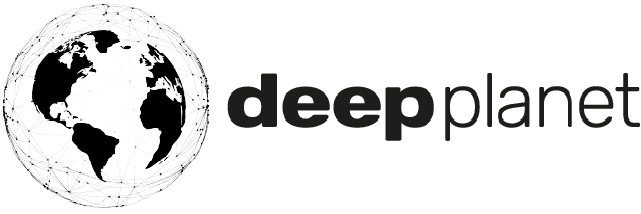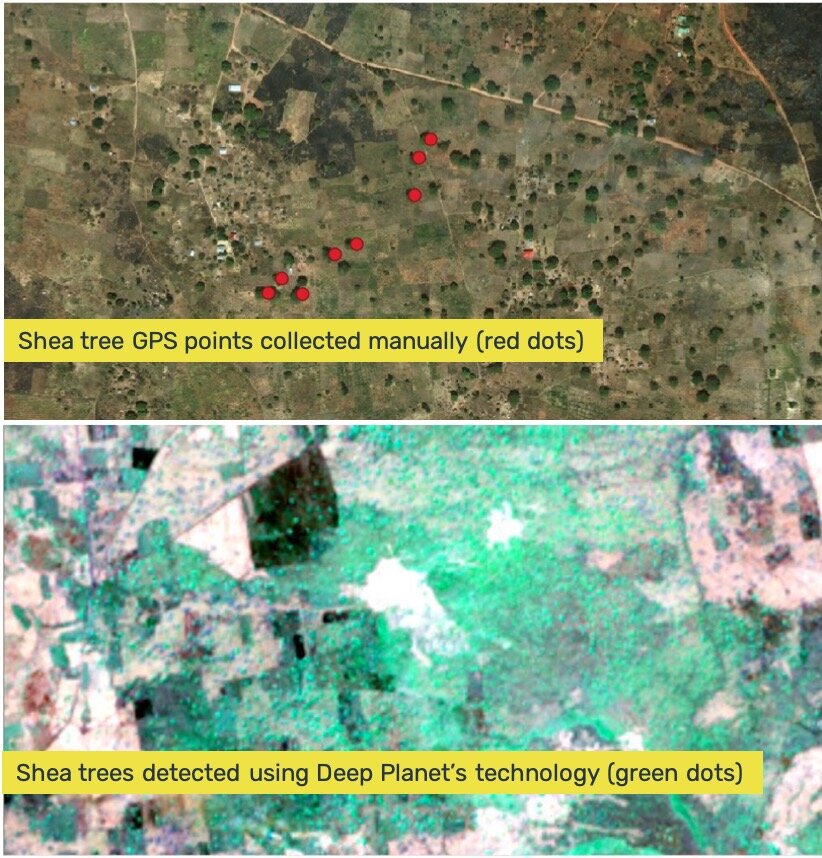Shea tree detection and monitoring with satellite imagery and AI
Shea trees can be remotely detected and monitored using satellites. This data can empower supply chain managers to reduce their manual scouting costs, improve their supply chain decisions and meet consumer demand for sustainably sourced products.
Shea trees
Shea trees grow in a narrow belt of African savanna stretching between the continent’s east and west coasts. The shea supply chain in West Africa is responsible for almost all international exports, whilst the industry in East Africa is underdeveloped despite the relative regional prevalence of shea nilotica trees – which produce the very high quality product, muyao butter.
Current best practice
Sourcing managers in supply chain companies currently rely on large, ground-based teams to scout and survey productive regions multiple times during the shea tree growing season, which starts in November. Sourcing managers face a variety of challenges with their current methods.
Cost- and labour-intensity. Depending on crop type and region size, manual scouting can be costly for supply chain companies. The ongoing pandemic has made these activities more sporadic and cost-intensive. Technologies such as unmanned aerial vehicles, drones, and planes also have higher operational costs compared to the use of satellite imagery.
Accuracy. Current methods are prone to subjective assessments of tree and forest health and density. While shea tree supply in West Africa is well-understood, equivalent assessments of supply in East Africa are lacking due to political and economic instability in the region. This could lead to inaccurate yield forecasts and sub-optimal supply planning.
Scalability. Lack of a reliable method to monitor trees on a large scale is a critical issue because of the crop’s wide distribution – current estimates show 18 trees per hectare, which can be extrapolated to nearly 1 billion trees distributed across 49.9 million hectares in West Africa alone (FAO-GSA 2020).
In addition, sourcing managers face two further challenges.
Knowledge. There exists a knowledge gap between growers and supply chain companies with regards to the number of shea trees in the region and, therefore, production and harvesting possibilities. Inability to assess and better manage the trees can cause supply planning problems because of the scarcity of nuts during lean seasons.
Sustainability. The long-term preservation of shea tree crops in the region is also at risk from people cutting down trees for charcoal and clearing land for agriculture. Deforestation and biodiversity loss negatively affect shea tree populations’ regeneration and pollination, both of which are already comparably low (Bommarco et al. 2013). Current methods may not allow companies to monitor and plan for these long-term trends.
Our solutions
Deep Planet has the capability to detect and monitor agricultural production around the world using satellite imagery. In recent years, the number of satellites in the atmosphere has significantly increased, as has the frequency with which they capture images and the resolution of those images.
©2020 Deep Planet
Tree density and count. Using a combination of high-resolution and low-resolution satellite imagery and ground data, our machine learning models can detect shea trees across Africa. Knowing where trees are growing, what species they are, and how many there are provides the tree count accuracy companies need to make optimal sourcing decisions and identify new opportunities. Especially in regions unsuitable for manual scouting, using satellite imagery for crop mapping is a scalable and cost-effective way for international companies to gain over their competition.
Yield prediction. We leverage ground data, satellite data, and crop health data to provide unbiased, accurate, and scalable yield estimates for shea tree crops that can complement existing forecasting tools used by supply chain companies.
Environmental sustainability trends. Our platform analyses historical satellite imagery to extract key trends in shea trees’ growing environments over time. Monitoring the long-term impacts of climate change and deforestation on shea crop health informs more precise supply planning and proactive yield improvements. Knowing where over-harvesting and deforestation is occurring informs better conservation efforts, which prevent cutting for charcoal and agriculture.
Regeneration and productivity. The slow regeneration rates of shea trees and their increasing use for charcoal poses a serious problem for the supply. As a result, the productive potential of these trees is estimated to be 42% on average (Lovett, 2004). Our platform provides an assessment of tree productivity and monitors both the tree growth cycle and the regeneration rates of young and mature trees.
Pollination and biodiversity. As shea fruit is dependent on insect pollination, yields benefit from biodiversity. Studies have shown that shea fruit production in areas with low tree and shrub diversity (e.g. those near to areas cleared for intensive cultivation) is severely limited by lack of pollination, whilst pollinators and pollination are boosted in areas of higher biodiversity (Delaney et al. 2020). Continuous monitoring of biodiversity in shea growing regions through satellite imagery helps sourcing managers understand how shea yield will be affected by pollination levels and changing biodiversity patterns.
Organic shea detection. Satellite imagery can also be used to detect organic and wild-growing shea trees because organic and conventional crops have different characteristics, which can be detected from space. The ability to trace the trees from which supply companies’ shea butter is procured can help companies achieve organic and wild-crafted certifications.
People. Enabling local communities to thrive while investing in sustainable harvesting has become a priority for many international brands involved in the shea industry. The Body Shop, for example, prides itself on its sustainably sourced shea butter. Crop mapping and yield prediction aims to provide economic value to regions where shea trees grow through employment of women and increases in household income, which finance education for children and improve household food security (FAO-GSA 2020).
Using our innovative methods, supply chain companies can digitise their shea tree monitoring capability to get frequent and accurate estimations of yield and assessments of tree density and health, thus reducing their reliance on ground-based activities. Our state-of-the-art technology can enable sourcing managers to identify and monitor shea trees over East and West Africa and enhance the traceability of organic and wild-crafted supply.
Want to know more about how satellite imagery and AI can help you improve your shea supply? Register for a demo here.



